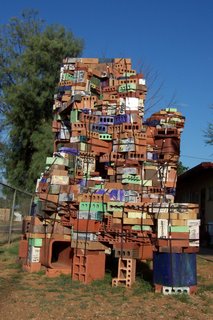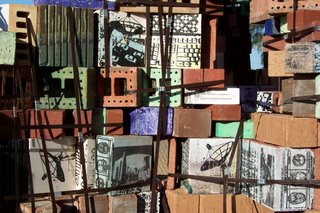Watching people interact--or not--with the work at the MCA: what is it folks expect from the work, from the experience of looking at it? Transcendence of some kind? Authenticity? Perhaps this informs the engagement with art at places like the AI and MCA. This idea that it is meant, first of all, to be a kind of experience of authenticity: if what you're after is the spirit of the authentic or the authentic expression by the artist, you want in on all that good 'aura'.
Lionel Trilling, in Sincerity and Authenticity:
The work of art is itself authentic by reason of its entire self-definition: it is understood to exist wholly by the laws of its own being, which include the right to embody painful, ignoble or socially inacceptable subject matters. Similarly the artist seeks his personal authenticity in his entire autonomousness--his goal is to be as self-defining as the art-object he creates. As for the audience, its expectation is that through its communication with the work of art, which may be resistant, unpleasant, even hostile, it acquires the authenticity of which the object itself is the model and the artist the personal example.1971? The old days. Who just thought of The Utter Shit School of Art?
There is some pretty challenging, some confrontational work at MCA, work that borders on a kind of hostility to its audience. And people breeze by, checking things out and checking things off: Saw that. It was cool.
 We had the pleasure of hosting Fred Spaulding for a few nights a couple of weeks ago while he worked on an installation here in Encinal. Fred, who also teaches, is working on a "guide to thinking critically about art." One of his goals in writing the guide (as I understood his goals) is not so much to answer the questions so often overheard in galleries and museums ("he gets paid for that?" or "is it a bear? what is it?") as to encourage people who want something from their experiences with art to ask different kinds of questions. I told him I thought listening to families talk about art in major metropolitan museums is like listening to students talk about poetry: instead of asking, first, if they like it, if it engages them, if it triggers some response or memory or desire, students reading poetry usually want to know, immediately (even before they have heard or read, really, all of the words) what does this mean? No, really: what does it mean?
We had the pleasure of hosting Fred Spaulding for a few nights a couple of weeks ago while he worked on an installation here in Encinal. Fred, who also teaches, is working on a "guide to thinking critically about art." One of his goals in writing the guide (as I understood his goals) is not so much to answer the questions so often overheard in galleries and museums ("he gets paid for that?" or "is it a bear? what is it?") as to encourage people who want something from their experiences with art to ask different kinds of questions. I told him I thought listening to families talk about art in major metropolitan museums is like listening to students talk about poetry: instead of asking, first, if they like it, if it engages them, if it triggers some response or memory or desire, students reading poetry usually want to know, immediately (even before they have heard or read, really, all of the words) what does this mean? No, really: what does it mean?And yet--since I've strayed into Helmut's DeweyWorld almost accidentally--maybe the most optimistic way of looking at all of this is to remember the distinction between "art products" and "works of art." Many of the families finding their way to the Art Institute have wandered there from the Navy Pier, a frantic agglomeration of kiosks and fast food and families on vacation spending sprees. Putting aside the question of why they're going to the CAI (because I have no idea, really), doesn't it seem obvious that their experience--in that context in that context--is of 'art products'? That, moreover, the fruit of that experience, if it bears fruit, is that sense of being connected to the authentic?
I'm happy to come home to Fred's piece, here in Encinal, way, way far away from any institutional museum space. The installation has elicited a lot of talk. It strikes me, out here in the middle of a sma
 ll town in the middle of nowhere, as being a healthy way to exhibit and experience (or not) the arts. I've seen Fred's work in gallery spaces and museum spaces and liked it. But here, it isn't about authenticity, first, at least: it's just some art stuck out there on the landscape. You can even sit or bump your head on it. Getting close, you might think about why Fred has glazed such quotidian imagery on bricks and then stacked them crazily. You might not. But I bet you're not worried about whether or not it really qualifies as art, whether or not somebody has decided it is important and authentic.
ll town in the middle of nowhere, as being a healthy way to exhibit and experience (or not) the arts. I've seen Fred's work in gallery spaces and museum spaces and liked it. But here, it isn't about authenticity, first, at least: it's just some art stuck out there on the landscape. You can even sit or bump your head on it. Getting close, you might think about why Fred has glazed such quotidian imagery on bricks and then stacked them crazily. You might not. But I bet you're not worried about whether or not it really qualifies as art, whether or not somebody has decided it is important and authentic.Perhaps if, in the context of the museum space, people were encouraged to see both the creative and the curatorial processes as human, we could get back some of the value of those spaces, too. I get the impression, though, that most folks see exhibits of famous artists as manifestations of verity of some kind, taking solace in the idea that Someone in Charge has arranged all of these pieces in such a way that they will express something profound, assuage the spirit. Certainly, the Art World hasn't helped, with its institutionalization of authentic free expression somehow suggesting that, if it's on the wall, it belongs on the wall. I think too many people accept that--whether they're in a private gallery or the Guggenheim, and that strikes me as important and sad.
Here's Helmut, from a few days ago, summarizing the problem angrily, in The Utter Shit School of Art:
I'm willing to go to the limit on what counts as "art." But I have no patience whatsoever with shit that counts as art because galleries have created a scene in which they bleed off each other like mud-caked leeches. Apart from the decorative utilitarian crap most galleries use to earn their feudal keep, the Utter Shit School began - arguably, of course - with Damien Hirst and Jeff Koons. It continues with idiots like Hurd. Oh, yes, but I hear your plaintive aesthetophilic cries. The art world thrives on denouncing those who don't get it. Yes, art world, many of us do get it. We are just waiting to be contacted when the artworld is over its Utter Shit Phase.Further reading: John Carey's recent What Good are the Arts?
The photos here are of Fred Spaulding's installation in Encinal at Hecho en Encinal. July, 2006.
1 comment:
Solved!
Post a Comment